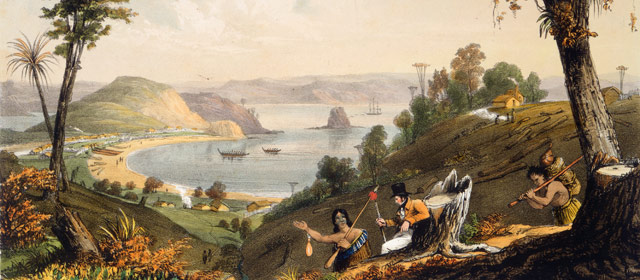Story summary
Māori settlement
The Māori people are Polynesians. Recent research confirms that these first settlers probably arrived from Polynesia shortly before 1300 CE. They lived in tribal groups, gardening, catching birds and fish, and making tools, weapons and ornaments.
The first Europeans
The Dutch explorer Abel Tasman was the first European to discover New Zealand, in 1642. The English navigator James Cook mapped the country in 1769–70. After this, sealers, whalers and traders arrived. From 1814, missionaries tried to convert Māori to Christianity, and taught them farming skills, reading and writing.
1840s–1850s: a new British colony
As more settlers arrived, the British government decided to take control of New Zealand. In 1840, Māori signed the Treaty of Waitangi with representatives of the British Queen, who sought sovereignty over the country. In return the Queen’s representatives promised Māori ownership of their land, and the rights of British citizens.
1860s–1880s: conflict and growth
Māori were pressured to sell their land for settlements. In the 1860s, war broke out, and land was confiscated or bought. New Zealand made money selling its wool and gold overseas. In the 1870s, the government helped thousands of British people start a new life in New Zealand. Railways were built and towns sprang up or expanded.
1890s–1945: social change and war
Among other reforms, New Zealand became the first country to give women the vote, in 1893. In the First World War, it joined Britain in the fight against Germany. In the 1920s and 1930s many New Zealanders suffered hardship in a world-wide depression. In 1935 they elected a Labour government which passed laws aimed at giving everyone a decent standard of living. During the Second World War, New Zealand troops again served overseas.
The later 20th century
From the 1950s, New Zealand widened its outlook beyond Britain, which had been the main market for the country’s meat, wool, butter and cheese. It began to sell its goods to many different countries, and was increasingly influenced by the United States. At the same time, it kept its identity as an independent nation.
Changes for Māori
Many Māori moved to the cities after the Second World War. It was not until 1975 that their concerns about their treatment by previous governments began to be taken seriously, and breaches of the Treaty of Waitangi were investigated. From about this time Māori began reviving their language and culture.
A more diverse nation
For a long time New Zealand wanted to remain ‘white’. But since the 1970s many more ethnic groups have been allowed to settle – from the Pacific Islands, Asia and every part of the globe.





